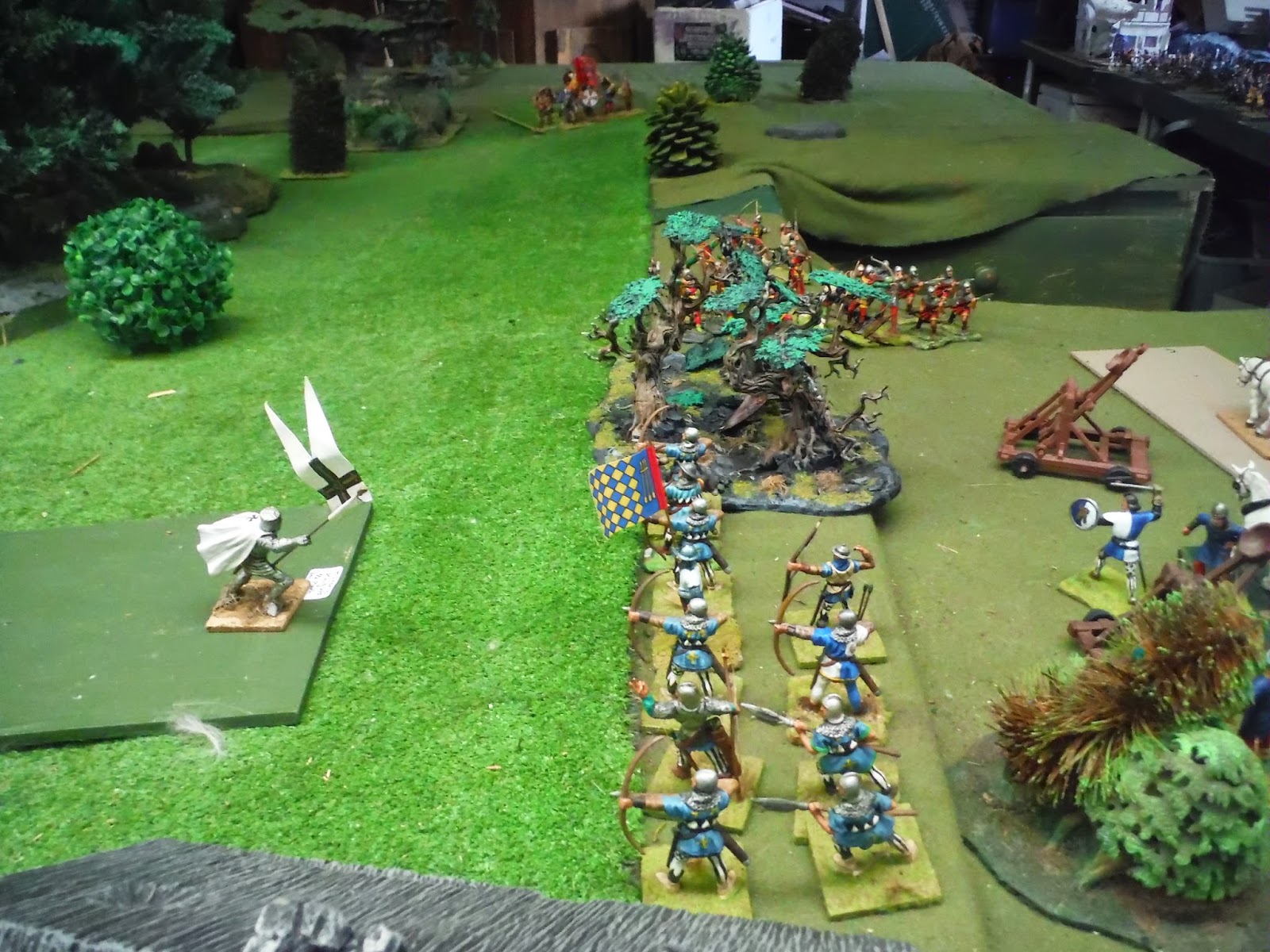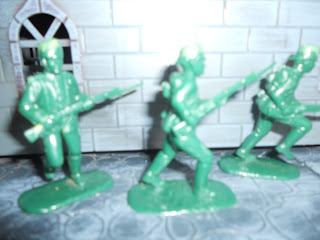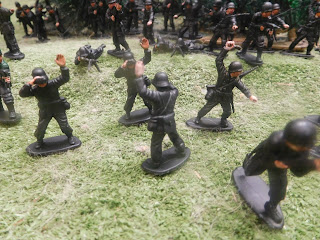Battle Of The Wandering Woods
Confident, haughty and arrogant, the Beersteiner army, led by their king pursued the fleeing Bogavanian army into and found itself in yet another forest. Much of the army became lost and delayed in their pursuit. The crusaders and men-at-arms were on the right trails and charged forward towards the depleted Bogavanian army. The archers had entered some particularly heavy forest but followed as best they could. The Bogavanians were waiting with their archers and catapults. The crusaders and men-at-arms were met with a hail of arrows followed by a lucky shot by a catapult. For once the Bogavanians were well deployed. The Bogavanian mounted knights, such that had survived then ploughed into the foot crusaders. Such was the Beersteiner fanaticism that they could not be deterred but some casualties were made before the mauled mounted knights fled. More arrows met the crusaders until all were killed.
Meanwhile Bogavanian peasants poured forth on the Beersteiner right flank. The Beersteiner knights charged into them but the peasants fled and the Bogavanian archers caused more casualties on the Beersteiner knights who then charged at the peasants again only to fall into a trap when a small unit of halberd armed Bogavanians charged into their flank.
Despite the horrendous casualties inflicted on the Beersteiners their archers were flanking the Bogavanians on their left and they killed all the crew of one of the catapults. Beersteiner crossbowmen had also reached the edge of the forest and shot a deadly volley into the Bogavanian light archers. The return volley was less effective due to the cover afforded the crossbowmen by the forest. Beersteiner mercenary Hillmen were also arriving but to late to participate in the battle.
Despite the precarious position of the Bogavanians right flank a demoralizing event occurred for the Beersteiners. You may recall that in the Battle of the Whispering Woods Red Sonya had been knocked unconscious but that her Hill Men marched off the field of battle. Red Sonya was still recovering from her serious wounds but her men had returned only to change sides and to join the Bogavanians. It is true that they were still some distance from the battle but they would emerge behind the flanking Beersteiner archers. The Beersteiners left the field of battle to the Bogavanians.
The Bogavanians had put up an unexpectedly tough resistance despite the loss of their Earl in the Battle of the Whispering Woods. His subordinate officers had organised the defence and the soldiers were prepared to put up a fight given the rumors of the Beersteiner Inquisition.
Bogavanians take defensive positions.
Beersteiner archers flank the Bogavanian catapults.
Meanwhile Bogavanian peasants poured forth on the Beersteiner right flank. The Beersteiner knights charged into them but the peasants fled and the Bogavanian archers caused more casualties on the Beersteiner knights who then charged at the peasants again only to fall into a trap when a small unit of halberd armed Bogavanians charged into their flank.
Despite the horrendous casualties inflicted on the Beersteiners their archers were flanking the Bogavanians on their left and they killed all the crew of one of the catapults. Beersteiner crossbowmen had also reached the edge of the forest and shot a deadly volley into the Bogavanian light archers. The return volley was less effective due to the cover afforded the crossbowmen by the forest. Beersteiner mercenary Hillmen were also arriving but to late to participate in the battle.
Despite the precarious position of the Bogavanians right flank a demoralizing event occurred for the Beersteiners. You may recall that in the Battle of the Whispering Woods Red Sonya had been knocked unconscious but that her Hill Men marched off the field of battle. Red Sonya was still recovering from her serious wounds but her men had returned only to change sides and to join the Bogavanians. It is true that they were still some distance from the battle but they would emerge behind the flanking Beersteiner archers. The Beersteiners left the field of battle to the Bogavanians.
The Bogavanians had put up an unexpectedly tough resistance despite the loss of their Earl in the Battle of the Whispering Woods. His subordinate officers had organised the defence and the soldiers were prepared to put up a fight given the rumors of the Beersteiner Inquisition.
Bogavanians take defensive positions.
Beersteiner archers enter some thick forest
Beersteiner crusaders and men-at-arms move through the open forest towards the Bogavanian archers.
The men-at arms retreat from the Bogavanian archers.
A trap awaits the Beersteiner knights.
Turncoat Hill Men march to join the Bogavanians.
Beersteiner archers flank the Bogavanian catapults.
The crusaders are destroyed.
Beersteiner crossbowmen open up on Bogavanian long bowmen.
Hillmen mercenaries in Beersteiner employ arrive too late.
MECHANICS
Twelve sided dice were used with tables to determine what scores for various bows were required at different ranges on different armour. Tables were also used for melees with weakest being peasants and strongest mounted plate armoured knights. A unit impacting another got to go first and after that it was by highest initiative with a 'Viking class' of heavy infantry having higher initiative than foot knights but less survivability due to weaker armour. These were the 'Hill Men'. Normally two ranks would be involved but those in a unit that over-lapped more than a figure each side of the fight could not be involved. You could make your unit as wide as you liked but could lose rank bonus. I was influenced by the rules called Chainmail and also Warhammer.
Losers of melees were pushed back 20cm - an influence of 'Adelaide Rules' of Bob and Steve. Once a unit got to breaking point leadership was tested and if failed a dice rolled to see if the unit fled, was captured or wiped out. A unit pushed off the board was out of the battle. This could be simplified to units just being removed if preferred. Mounted knights got a bonus for impact and also for use of a lance first round. Halberds got a bonus of plus one. Two handed 'great weapons', mostly axes were given plus two but always went last. Spearmen got three ranks to fight instead of two. Figures in base to base and the rank behind plus immediate overlapping figures got to fight.
Characters got extra attacks and higher leadership plus saving throws. A character who lost all his wounds (two or three, unlike rank and file) was not dead but 'unconscious' and would be a captive if his unit or side lost and he was in enemy territory. The character could not come back in the next battle if it coincided with a map move. If he died again it would be final. This rule depends on how much you want your characters to survive.
The map moves decided the terrain and position of battles. When any of the four armies of each side met in a hexagon a battle was declared. All such battles had to be fought before another map move could occur. We basically used the same figures for each army except that only one army had the king and others had various heroes.
For simplification it was assumed that all figures in a unit had the same weapons except sometimes for heroes. A flag and musician added to combat results as did extra ranks up to three. Sometimes a unit which inflicted fewer casualties could thus still win a round of combat if it was more numerous and the casualty difference not too great. A unit could decide to not push back if it won a leadership test.
Knights also had to charge initially and would first focus on other knights. Fanatics leadership was set so high it was very unlikely they would run from a melee. Berserkers would fight to the last man and got two dice for each figure on impact but they always charged.
At the end of a battle each surviving unit could have some casualties come back as recovered wounded. This was 25% of casualties for the losing side and 50% of casualties for the winning side. (Thanks Bob Bolton for this idea). Units pushed off the board or deserted required higher dice rolls to enter the next battle.
The rules worked well, being simpler than Warhammer but with a reasonable degree of complexity.























Comments
Post a Comment